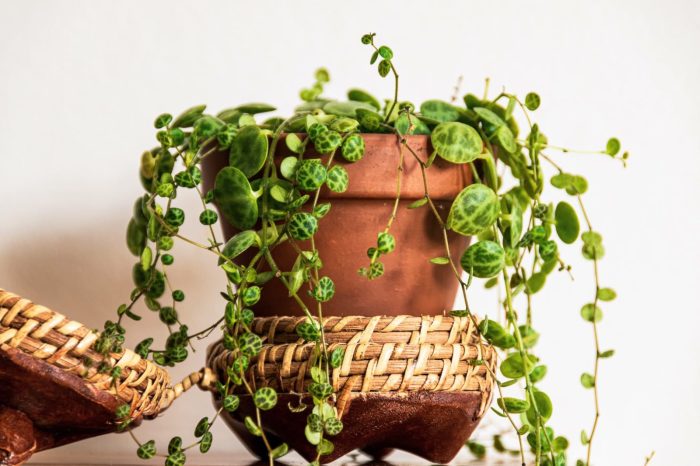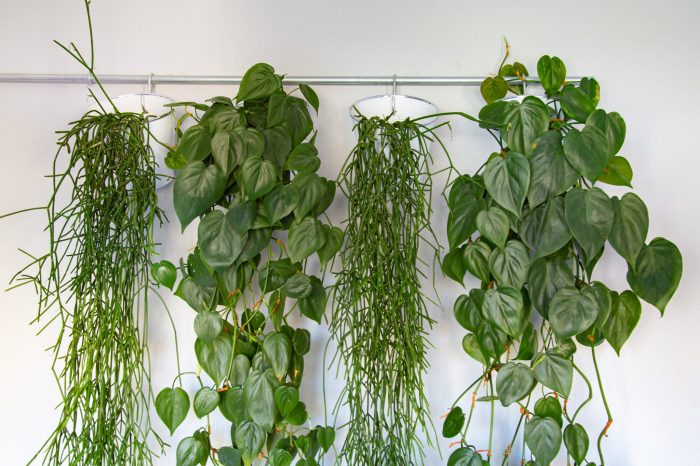Easy trailing house plants – With easy trailing houseplants taking center stage, this article invites you to discover a world of lush greenery and cascading charm. From their unique characteristics to their ability to enhance home decor and purify the air, these plants are a must-have for any plant enthusiast.
Whether you’re a seasoned gardener or a novice seeking to add a touch of nature to your living space, easy trailing houseplants offer a wide range of options to suit your needs. Let’s delve into the captivating world of these graceful plants and explore their beauty and benefits.
Plant Varieties

Trailing houseplants bring a touch of nature and elegance to any home. They add a cascading effect, softening corners and adding interest to shelves and tables. With their diverse foliage and easy care requirements, these plants are perfect for beginners and experienced gardeners alike.
Varieties of Trailing Houseplants
Here is a comprehensive list of easy trailing houseplants:
-
-*Pothos (Epipremnum aureum)
Trailing houseplants bring a touch of greenery and elegance to any room. If you’re looking for low-maintenance options, consider easiest hanging houseplants such as pothos, philodendron, and spider plants. These varieties thrive in hanging baskets, adding a touch of vertical flair to your home décor while purifying the air and creating a cozy ambiance.
Known for its heart-shaped leaves and trailing vines, Pothos is a low-maintenance plant that tolerates neglect and low light. It is available in a variety of colors, including green, yellow, and white.
-*Spider Plant (Chlorophytum comosum)
With its arching leaves and trailing plantlets, the Spider Plant is a popular choice for hanging baskets. It is known for its ability to purify the air and is easy to propagate.
-*String of Pearls (Senecio rowleyanus)
This unique plant has delicate, pea-shaped leaves that cascade down like strings of pearls. It prefers bright indirect light and well-draining soil.
-*Burro’s Tail (Sedum morganianum)
With its fleshy, cylindrical leaves that resemble a donkey’s tail, this plant is a slow-growing succulent that prefers bright light and infrequent watering.
-*Creeping Fig (Ficus pumila)
If you’re looking for a way to add some greenery to your home without taking up too much space, easy trailing house plants are a great option. These plants are perfect for hanging baskets or shelves, and they can add a touch of elegance to any room.
For more information on house plants, visit Plants . Trailing plants are also a great way to add some color and life to a room, and they can help to improve air quality. They are a relatively low-maintenance option, making them a great choice for busy people or those who are new to gardening.
This vigorous plant has small, heart-shaped leaves that creep along surfaces, making it an ideal choice for covering walls or furniture. It prefers bright indirect light and moist soil.
-*Wandering Jew (Tradescantia zebrina)
Known for its variegated leaves with purple undersides, the Wandering Jew is a fast-growing plant that tolerates low light and infrequent watering.
-*Swedish Ivy (Plectranthus australis)
This trailing plant has small, rounded leaves with scalloped edges. It prefers bright indirect light and moist soil, but it can tolerate some neglect.
-*Trailing Jade (Crassula ovata ‘Hummel’s Sunset’)
A succulent with trailing stems and fleshy, spoon-shaped leaves, the Trailing Jade prefers bright light and well-draining soil.
-*Hoya (Hoya carnosa)
This plant has waxy, succulent leaves and produces clusters of fragrant flowers. It prefers bright indirect light and infrequent watering.
-*Golden Gate (Epipremnum pinnatum ‘Golden Gate’)
A cultivar of Pothos, the Golden Gate has large, variegated leaves with bright yellow and green patterns. It prefers bright indirect light and moist soil.
Care and Maintenance

Maintaining the health and beauty of easy trailing houseplants requires proper care and attention. By understanding their optimal lighting, watering, and temperature requirements, as well as effective propagation and repotting techniques, you can ensure their thriving growth and aesthetic appeal.
Optimal Conditions, Easy trailing house plants
- Lighting:Most trailing houseplants prefer bright, indirect light. Avoid placing them in direct sunlight, as this can scorch their leaves. Some varieties, like pothos and philodendrons, can tolerate lower light conditions.
- Watering:Allow the top inch of soil to dry out before watering. Overwatering can lead to root rot, while underwatering can cause wilting and brown leaves. Use room-temperature water and avoid getting water on the leaves.
- Temperature:Most trailing houseplants thrive in temperatures between 65-80°F (18-27°C). Avoid exposing them to cold drafts or extreme heat.
Propagation and Repotting
Propagating trailing houseplants is a simple way to create new plants or rejuvenate existing ones. Many varieties can be propagated through stem cuttings. To do this, take a healthy stem with several leaves and cut it below a node. Remove the lower leaves and place the cutting in water or moist soil.
Keep the cutting in a warm, bright location until roots develop.
Repotting is necessary when the plant becomes rootbound or outgrows its current pot. Choose a pot that is slightly larger than the previous one and use a well-draining potting mix. Carefully remove the plant from its old pot and gently loosen any tangled roots.
Place the plant in the new pot and fill it with soil, gently firming it around the base of the plant.
Troubleshooting Common Problems and Pests
Trailing houseplants are generally hardy, but they can sometimes experience problems or pests. Here are a few common issues and how to address them:
- Yellowing leaves:This can be caused by overwatering, underwatering, or nutrient deficiency. Adjust your watering schedule or fertilize the plant accordingly.
- Brown leaf tips:This is usually a sign of underwatering or low humidity. Increase watering frequency or mist the leaves with water.
- Mealybugs:These small, white insects can infest leaves and stems. Use a cotton swab dipped in rubbing alcohol to remove them.
- Aphids:These tiny, green insects can suck sap from leaves. Spray the plant with insecticidal soap or neem oil to control them.
Aesthetic Considerations: Easy Trailing House Plants
Trailing houseplants captivate with their cascading foliage, adding a touch of elegance and natural beauty to any space. Their long, flowing stems adorned with lush greenery create a captivating visual appeal that transforms ordinary rooms into vibrant oases.The versatility of trailing plants allows them to complement various home decor styles.
They can lend a bohemian touch to eclectic spaces, introduce a touch of whimsy to modern interiors, and bring a sense of tranquility to minimalist settings. By incorporating trailing plants into vertical arrangements or suspending them from hanging baskets, homeowners can create stunning displays that draw the eye upwards, adding depth and dimension to their living spaces.
Placement and Arrangement
Strategic placement and arrangement of trailing houseplants are key to maximizing their aesthetic impact. Suspending them from the ceiling or placing them on high shelves allows their cascading foliage to cascade gracefully, creating a captivating focal point. Utilizing plant stands or pedestals elevates these plants, showcasing their beauty while adding height and interest to the room.
Easy trailing house plants can add a touch of greenery to any room, but some are easier to keep alive than others. For those who want the benefits of hanging plants without the hassle, consider easiest hanging plants to keep alive . These plants are known for their resilience and can tolerate a variety of conditions, making them ideal for beginners and busy individuals.
Trailing house plants can also help purify the air and improve overall well-being.
Color and Texture
The diverse range of colors and textures found in trailing houseplants offers endless possibilities for creating visually striking displays. Variegated varieties with contrasting shades of green or splashes of white add a touch of vibrancy to any space. Plants with velvety leaves, such as the Persian shield, provide a luxurious and tactile element, while those with glossy foliage, like the spider plant, reflect light, brightening up even the darkest corners.
Indoor Air Quality
Trailing houseplants are not only aesthetically pleasing but also contribute to a healthier indoor environment. They have the remarkable ability to purify the air, removing harmful toxins and pollutants that can affect our well-being.
Studies have shown that certain plant species effectively remove volatile organic compounds (VOCs) from the air. VOCs are emitted from various sources, including building materials, cleaning products, and personal care items. Some common VOCs include benzene, formaldehyde, and trichloroethylene, which can cause respiratory problems, headaches, and other health issues.
For those looking to add a touch of greenery to their homes without the hassle, easy trailing house plants are a great option. These plants, such as easy care trailing plants , require minimal maintenance and can thrive in various indoor environments.
They’re perfect for hanging baskets, shelves, or windowsills, adding a lush and vibrant touch to any space.
Specific Air-Purifying Plants
- Spider Plant (Chlorophytum comosum):Known for its long, trailing leaves, the spider plant effectively removes formaldehyde and xylene from the air.
- Peace Lily (Spathiphyllum wallisii):This plant is highly efficient in removing benzene, formaldehyde, and trichloroethylene from the air.
- Snake Plant (Sansevieria trifasciata):A popular choice for its hardiness, the snake plant absorbs carbon dioxide at night, releasing oxygen and purifying the air.
- Golden Pothos (Epipremnum aureum):This trailing vine is known for its ability to remove formaldehyde, benzene, and carbon monoxide from the air.
- English Ivy (Hedera helix):A vigorous climber, English ivy effectively removes formaldehyde and benzene from the air, improving indoor air quality.
To optimize the air-purifying effects of trailing houseplants, it is recommended to:
- Choose a variety of plants:Different plant species have different air-purifying capabilities, so selecting a variety of plants can maximize the removal of various pollutants.
- Place plants in high-traffic areas:To effectively purify the air, place trailing houseplants in areas where people spend the most time, such as living rooms, bedrooms, and offices.
- Provide adequate light:Most trailing houseplants require bright, indirect light to thrive. Ensure they receive sufficient light for optimal air-purifying performance.
Plant Styling

Trailing houseplants offer versatility in home decor, adding a touch of greenery and elegance to various spaces. Whether you prefer hanging baskets, shelves, or windowsills, these plants can create a captivating visual impact.
Hanging Baskets
- String of Pearls (Senecio rowleyanus):Its cascading, pearl-like foliage creates a mesmerizing effect.
- Spider Plant (Chlorophytum comosum):Produces long, arching stems with variegated leaves.
- Burro’s Tail (Sedum morganianum):Features plump, succulent leaves resembling a donkey’s tail.
Shelves
- Pothos (Epipremnum aureum):Known for its heart-shaped leaves with vibrant patterns.
- Peperomia (Peperomia spp.):Offers a wide variety of species with unique leaf shapes and colors.
- String of Hearts (Ceropegia woodii):Displays charming, heart-shaped leaves with intricate patterns.
Windowsills
- Hoya (Hoya spp.):Produces waxy, fragrant flowers in clusters.
- Snake Plant (Sansevieria trifasciata):Features upright, sword-like leaves with variegated patterns.
- ZZ Plant (Zamioculcas zamiifolia):Tolerates low light and neglect, making it a great choice for busy individuals.
To create eye-catching arrangements, consider combining different trailing plants with contrasting textures and colors. Experiment with heights and lengths to create a dynamic effect. Decorative containers and trellises can further enhance the aesthetic appeal, adding a touch of sophistication to your plant display.
Ultimate Conclusion
In conclusion, easy trailing houseplants are a versatile and rewarding addition to any home. Their cascading foliage, air-purifying qualities, and aesthetic appeal make them a must-have for plant lovers and interior decorators alike. By incorporating these plants into your living space, you can create a serene and inviting atmosphere while enjoying the many benefits they offer.
FAQs
What are the most common types of easy trailing houseplants?
Some popular easy trailing houseplants include pothos, spider plants, philodendrons, and string of pearls.
How often should I water my trailing houseplants?
Water your trailing houseplants when the top inch of soil feels dry to the touch.
Can I propagate trailing houseplants?
Yes, you can propagate trailing houseplants by stem cuttings.